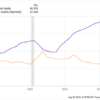
Shoe and sports apparel giant Nike (NYSE: NKE) is one of the all-time best-performing stocks, but you wouldn’t know if you’ve owned shares over the past few years. The stock has lost roughly half its value since peaking in late 2021. Sluggish sales momentum and competitive pressure have many declaring Nike a dinosaur beyond its best years.
Nike deserves some criticism. Management has admitted that the company has made some mistakes, and fixes are in motion.
But rather than take management’s word for it, investors can look at the company’s fundamentals for all the evidence they need to support buying and holding Nike at these depressed prices.
Here are three reasons to buy the Swoosh and never let go.
1. Nike’s demise is overstated
For decades, people have willingly paid a premium for Nike’s products. Some may argue that Nike’s soft sales momentum signals fading brand and pricing power, but it seems more likely that this is a consumer problem, not something specific to Nike.
Weak results from Starbucks and McDonald’s signal people are eating out less. Food companies like PepsiCo and Hershey are warning that consumers are passing on those impulse treats at grocery stores. Is it really a stretch to think that some consumers are simply holding off on buying that new pair of sneakers?
Sure, some smaller niche competitors like On and Hoka have gained popularity. Niche competitors aren’t new; about a decade ago, many argued rising star Under Armour was destined to knock Nike off its perch. That never materialized.
Why? Sports culture is about aligning with the iconic athletes that consumers look up to, and nobody beats Nike at this game, from legacy stars like Michael Jordan and LeBron James to new stars in key demographics, like Caitlin Clark in women’s basketball. They all represent the Swoosh.
2. The ability to pivot
As mentioned, Nike deserves some blame for its recent stumbles. First and foremost, the company made a strategic error in leaning too heavily into its direct-to-consumer business model. Nike underestimated the importance of wholesaler relationships.
Selling directly to consumers can be more profitable and give Nike more control. However, wholesalers help get the product in front of more people quicker, taking a lot of the logistics and other work off Nike’s shoulders. Management felt it had neglected its wholesaler relationships enough to make it a point last quarter to emphasize increasing investments in rebuilding momentum with wholesalers, including rehiring retired executive Tom Peddie to oversee those efforts.
Will this shift spark sales momentum? It’s hard to say, especially given current consumer weakness. Still, Nike has dominated for a long time because it’s wise and bold enough to recognize when something isn’t working and make the necessary changes.
3. Strong financials support earnings growth
Earnings growth is arguably the most critical factor in a stock’s long-term investment returns. Nike has returned over 76,000% over its time as a publicly traded stock. How? A great business like Nike can push multiple buttons to grow earnings per share instead of relying solely on revenue growth.
Yes, Nike has grown into an industry titan, with over $51 billion in annual sales. But thanks to Nike’s strong profit margins, roughly $0.13 winds up as free cash flow, cash profits that management has spent on buying back its stock to reduce its share count. Having fewer shares increases Nike’s earnings per share, which helps support a higher share price over time.
Nike has repurchased roughly 13% of its shares over the past decade alone. The company also pays dividends to its shareholders, using the leftover cash flow. Today, Nike pays $0.37 quarterly, which translates to an annual sum of $1.48 for every Nike share you own. That yields 1.76% at the current share price, which adds to any share price appreciation.
Those dividends and share repurchases will likely continue. Nike’s balance sheet has $11.5 billion in cash and a strong AA-credit rating. The dividend payout ratio is only 33%. Even with stagnant sales, the company has enormous financial flexibility.
Of course, you probably aren’t buying Nike if you believe the brand has peaked. But history as shown that Nike has bounced back before, and if there is any company with the tools to reignite growth, it’s arguably the Swoosh.
Should you invest $1,000 in Nike right now?
Before you buy stock in Nike, consider this:
The Motley Fool Stock Advisor analyst team just identified what they believe are the 10 best stocks for investors to buy now… and Nike wasn’t one of them. The 10 stocks that made the cut could produce monster returns in the coming years.
Consider when Nvidia made this list on April 15, 2005… if you invested $1,000 at the time of our recommendation, you’d have $720,542!*
Stock Advisor provides investors with an easy-to-follow blueprint for success, including guidance on building a portfolio, regular updates from analysts, and two new stock picks each month. The Stock Advisor service has more than quadrupled the return of S&P 500 since 2002*.
*Stock Advisor returns as of August 26, 2024
Justin Pope has positions in Hershey. The Motley Fool has positions in and recommends Hershey, Nike, and Starbucks. The Motley Fool recommends Under Armour. The Motley Fool has a disclosure policy.
1 Magnificent S&P 500 Dividend Stock Down 52% to Buy and Hold Forever was originally published by The Motley Fool
EMEA Tribune is not involved in this news article, it is taken from our partners and or from the News Agencies. Copyright and Credit go to the News Agencies, email news@emeatribune.com Follow our WhatsApp verified Channel





